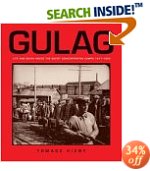Gulag: Life and Death Inside the Soviet Concentration Camps

by Tomasz Kizny
ISBN: 1552979644
Post Your Opinion | | A Review of: Gulag: Life and Death inside the Soviet Concentration Camps
by Olga SteinTo write a brief review of this books strikes me as almost a sinful
act, considering the scale of the human tragedy that is painstakingly
documented in this collection of more than 500 photographs. Norman
Davies contributes a moving, thoughtful introduction that attempts
to explain why so much of this human catastrophe has gone unnoticed-the
deaths of millions of people. The enduring communist sympathies of
many European and North American intellectuals is one disconcerting
reason. But principally what accounts for this lack of historical
awareness is the fact that, while alive, Stalin devised means of
keeping all information about the camps (which covered one tenth
of the old Soviet Union's entire territory) strictly secret. Davies
elaborates: "Systematic descriptions and statistics did not
begin to emerge until the Krushev era, when the worst excesses,
including the widespread use of slave labour, were abandoned."
Even afterwards, "Sovietologists had consistently denied both
the scale and the murderous nature of Soviet political repression."
The Gulag camp system was first established on the Solvetsky Islands
in 1923 and soon spread to the White Sea Coast, Karelia, the Urals,
and the Kola Peninsula. As the number of prisoners grew, this
population increasingly came to represent a "strategic
workforce." The White Sea Canal was the first "great
construction project." As many as 80,000 Gulag prisoners, men
and women, young and old, spent 20 murderous' months building a
180-kilometer canal, linking Lake Onega to the White Sea, using
only spades, pickaxes, hatchets, and wheelbarrows. Ill-conceived
and in the end of little strategic or economic use, the canal project
presaged an even greater fiasco, the construction of the Trans-Arctic
Railroad, which came to be known as "The Road of Death".
Began in 1947 on Stalin's whim, construction was initiated on the
sketchiest of plans. Stalin wanted a seaport at the mouth of the
Enisei River. A seaport required the support of a railroad, so
Stalin ordered one built to connect Salekhard and Igarka. Once
again, using the most primitive of tools, 70,000 prisoners (new
arrivals continually replaced the dead) labored in indescribable
conditions: wasting away from malnourishment and 12-hour daily work
shifts, in temperatures as low as minus 65 degrees Celsius, dressed
in ragged clothing. Of the 900 km of railroad built only a 190-km
section was ever used. Hundreds of thousands died building it.
Conditions were just as brutal in the Kolyma camps (in the Bugugychag
mountain range). Established in 1932 to mine gold deposits in the
upper and central parts of the Kolyma River, these were part of the
biggest prison camp system in the USSR. The next largest network
of camps was in Vorkuta, located 160 Kilometers above the Arctic
Circle. There, at the foot of the Arctic Ural Mountains, 15 coal
mines were surrounded by 150 camps, holding at all times, between
1931 and 1956, approximately 50,000 prisoners. In all of the camps,
the daily death tolls from exposure, starvation, and prisoner abuse
were staggering.
Who ended up in the camps? Initially, members of the Tsarist army,
the clergy, wealthy peasants. Soon the intelligentsia-writers,
artists, and scientist-followed. After WWII, there was a massive
influx of nationalists, those who fought the Soviet invasion of
their countries: men and women from the Ukraine, the Baltic Republics,
Poland, as well as Hungarians, Romanians, Czechs, Germans and
Japanese. Tragically, those who heroically fought the Nazis, and
soviet prisoners-of-war, accused of "betraying the fatherland",
also ended up in the camps.
A giant net was cast over Soviet Russia. It worked indiscriminately
to condemn millions. During The Great Purge (1937-8), it netted
even those who cast the net; the entire upper echelon of the dreaded
NKVD was executed or sent to death in the labour camps.
These photos remind us of the incalculable number of ruined lives,
ruined by the Communist experiment and a psychopathic dictator. The
photos and testimonials of the survivors provide a profoundly
disturbing but partial picture. There are many types of hell on
earth. To know the full horror, you had to be there.
This book addresses a chasm in our understanding of Stalinist and
Communist Russia. It's an important document.
|